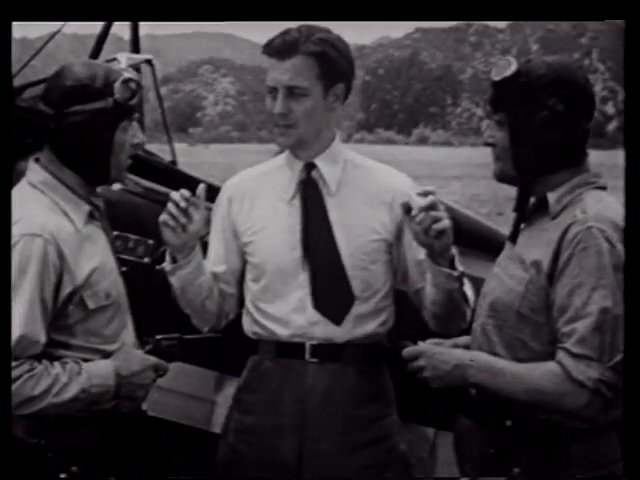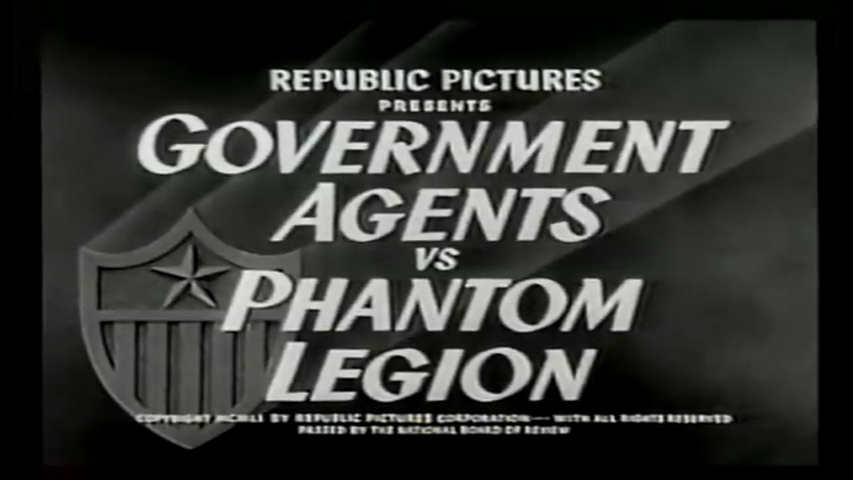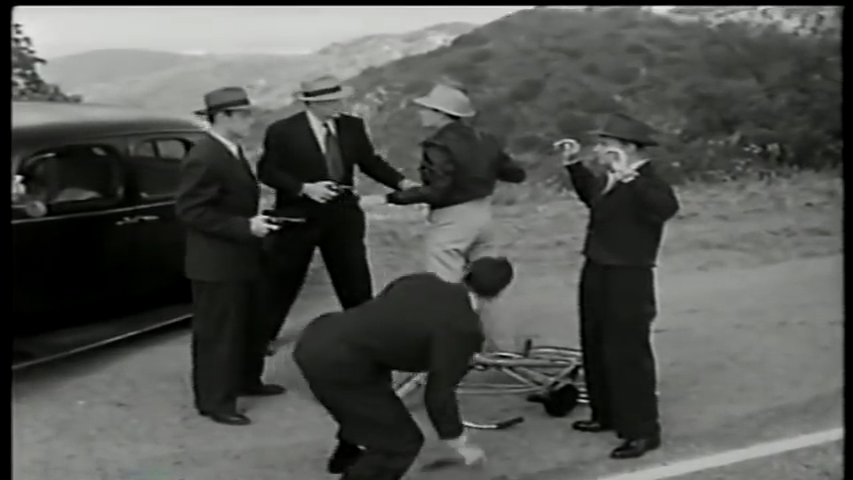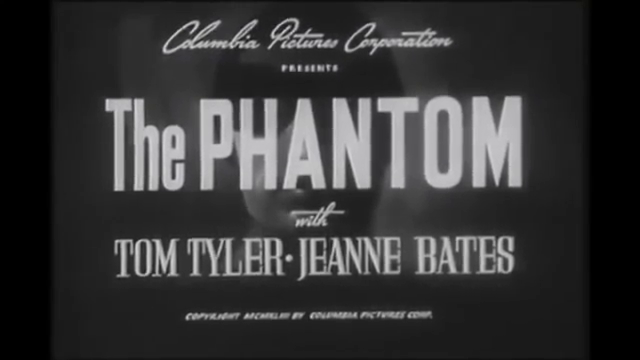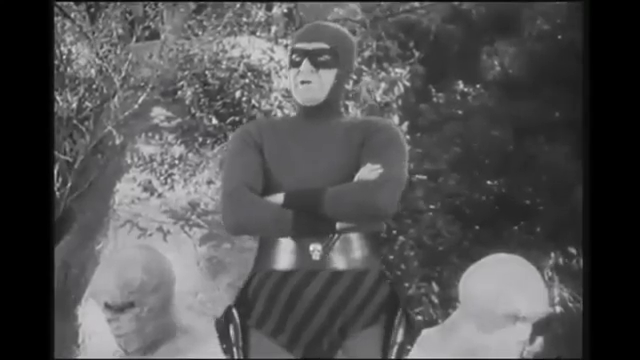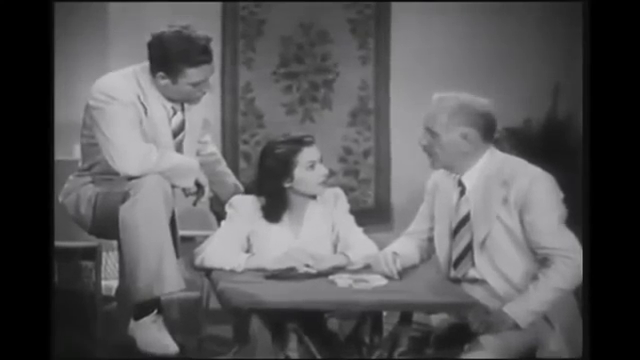-
#452 – Ace Drummond (1936)
Ace Drummond (1936)
Film review #452
Directors: Ford Beebe, Clifford Smith
SYNOPSIS: International Airways are planning to open a new air route through Mongolia, however, their airplanes are coming under attack by a mysterious villain who calls himself “the Dragon.” Ace pilot and G-man Ace Drummond is called in to investigate and put a stop to The Dragon’s plans to secure a secret mountain of jade for himself…
THOUGHTS/ANALYSIS: Ace Drummond is a 1936 Universal Pictures serial comprised of thirteen chapters, based on the comic strip of the same name. The comic was created by Captain Eddie Rickenbacker, one of the most famous U.S. pilots in World War I. The serial starts out with attacks on numerous airplanes owned by International Airways, who are working to establish a new air route through Mongolia. Ace Drummond, a pilot and “G-man of the air,” is called in to investigate the incidents, which are being masterminded by a criminal organisation led by a man known only as “The Dragon.” From there, the serial unfolds in a typical fashion, with Ace and his friends taking on The Dragon’s henchman in fistfights, shootouts and in the air. There’s plenty of story elements that fill the serial, and the story has a direction as situations change, which is something that many serials don’t do. The main plot of the serial is still a back-and-forth between the heroes and villains, but there’s some development with the characters and variety of settings that keep things relatively interesting. The plot concerning an airline and a secret mountain of jade isn’t the most exciting story, but there’s enough going on to not worry about the end goals.
The characters are a very typical cast of serial characters, starting with the youthful action hero Ace. There’s nothing too special about him, but he does sing…the exact same song nearly every chapter. It’s something to make him a little unique I guess, but other than that he’s just the standard lead. Peggy Trainor is the sole female character that is looking for her kidnapped relative, which is one of about only three roles that female characters got in these serials. Jean Rogers, who plays Peggy, also played Dale Arden in the Flash Gordon serial in the same year. The rest of the supporting characters are pretty unremarkable. A lot of the serial is set in a monastery, where many monks live alongside the Grand Lama. I assume that it’s supposed to be Buddhism in all but name, but I don’t think any effort was taken to accurately represent the culture, as with any non-American culture in this era. There are, at least, some of the Asian characters actually played by Asian actors, although the Grand Lama and some of the more prominent Asian characters are white actors made up to ‘look’ Asian. The Dragon doesn’t really do much as the villain: he communicates through some kind of spinning fan (I don’t know how it works), and he is suspected to be one of the people working with the airways, but that element of mystery is fairly commonplace. Each chapter ends with a pretty cool looking dragon model breathing fire as he proclaims “The Dragon commands it!” As mentioned, there’s a good variety of settings that the serial takes place in. The plane fights are decent, and the fight scenes are fairly well choreographed. The acting is decent from the main characters, but a bit stifled through some of the other characters. One more unique thing about is that the intro of each chapter begins with a recap of the previous one in the form of a comic strip, which is reminiscent of Ace’s origins.
Overall, I would say Ace Drummond is a decently crafted serial that while doesn’t provide anything spectacular from the characters or setting, still has a decently flowing story and enough action to elevate it above the average quality of these serials.
-
#451 – Gingerdead Man vs Evil Bong (2013)
Gingerdead Man vs Evil Bong (2013)
Film review #451
Director: Charles Band
SYNOPSIS: After his many encounters with the evil bong, Larnell has finally defeated her, and opened his own weed shop. Meanwhile, down the street, Sarah Leigh has opened up her own bakery, after putting the horror of the serial killing gingerdead man behind her. Larnell and Sarah Leigh talk about entering into a business agreement to support each others stores, but their respective past horrors return and set out to get their revenge on both of them…
THOUGHTS/ANALYSIS: Gingerdead Man vs Evil Bong is a 2013 comedy horror film, and is a crossover of the Gingerdead Man and Evil Bong film series, both made by Full Moon Features. The film brings together – as the title suggests – two villains from their titular horror franchises and pits them against some of the protagonist’s from said franchises. It never gets more complicated than that. The film is structured into a very blatant three act structure, with the first act focusing on the Evil Bong characters, the second act focusing on the Gingerdead Man side, and the third act is the clash and combination of the two. The film leans more towards being a part of the Evil Bong series, as there are more of its characters and the set up feels much more like the films. This is probably because Charles Band, the director of the Evil Bong films, directs this one too. Like most of the Evil Bong films, the film centres on two locations, and a lot of standing around talking, rather than anything actually happening. Some of the dialogue between the familiar characters of the series is fine, but the film also throws in minor characters that serve no purpose other than to push an unfunny joke. The film also fills up its runtime by providing flashbacks from both film series to catch you up on the three films (six in total) before this one takes place, but given that the film’s are a comedy horror that doesn’t really create a coherent narrative and instead focuses on innuendo and jokes, the flashbacks seem rather pointless (a part from to pad out the runtime, which is obviously what their purpose is).
As mentioned, a number of characters from both series make an appearance in this crossover. Larnell and Rabbit are the main characters that appear from the Evil Bong franchise, and they’re more or less how you’d expect them to be. On the Gingerdead Man side, there’s only Sarah Leigh who returns; mostly because everyone else is dead by the end of the films (Sarah Leigh also doesn’t even feature in the third film). With regards to the titular villains, they are their usual selves, and there’s no real showdown between the two; instead, they mostly just trade one-liners at each other when they finally meet near the end of the film. In the bong world, the Gingerdead Man goes ‘on trial’ where he is judged by other talking pastries which makes very little sense, and has even less impact on the story. There’s some smaller cameos from the other films in the franchise (through flashbacks or otherwise) that add a bit of depth, but not much.
While there were no more stand-alone Gingerdead Man films released after this film (or after 2011′s Gingerdead Man 3 to be exact), the titular villain went on to become a recurring character in the rest of the Evil Bong films, where he sometimes works with Evil Bong and sometimes against her, and sometimes just does his own thing. Sarah Leigh also shows up in further films, cementing a weird merger of the franchises. Overall though, Gingerdead Man vs Evil Bong sounds like a ridiculous clash of ridiculous premises, but like the stand-alone films, never lives up to the premise. The villains do very little and attention is focused on scenes of dialogue between characters that never goes anywhere. Then again, it should be what you expect if you’ve watched any of the other films, as they’re al low-budget comedy horrors that never take themselves seriously. This crossover doesn’t stand out from the rest, and fails to offer anything that the other films don’t.
-
#450 – Government Agents vs. Phantom Legion (1951)
Government Agents vs. Phantom Legion (1951)
Film review #450
Director: Fred C. Brannon
SYNOPSIS: A company carrying materials by truck to be used for military defense are being hijacked in transit by foreign agents. The company is assigned government agents Hal Duncan and Sam Bradley to put a stop to the criminals. Suspecting that one of the managers of the company is actually the ringleader of these hijackings, the agents must work to dismantle the crime ring and unmask the person responsible…
THOUGHTS/ANALYSIS: Government Agents vs. Phantom Legion is a 1951 serial comprised of twelve chapters. The plot is simple enough: a company which transports materials in trucks is being subjected to a number of hijackings. To resolve the situation, government agents Hal Duncan and Sam Bradley are brought in to bring the perpetrators to justice, as their investigation leads them to suspect that one of the four managers themselves is the ringleader of the gang of criminals. If that plot summary doesn’t sound very interesting, that’s because it’s not. There aren’t any real novel, unique or interesting elements to the story that give it anything to stand out. A plot centering on hijacking trucks just doesn’t compare to the fantastic adventures of Flash Gordon, and the characters of Hal Duncan aren’t particularly memorable or recognisable like Dick Tracy. The serial itself unfolds in typical serial format, with the heroes trying to thwart the villain’s various schemes while getting into brawls and gunfights. There really isn’t anything else to say on the story, because it is so devoid of life or interest that it’s difficult to pay attention while watching.
As mentioned, the lead characters are pretty unremarkable: the serial is not based on an existing comic, book or other media, and so there’s no prior name recognition to get people into the theatre, which is going to hinder this serial further when it already has nothing going for it. The lead characters are bland and uninteresting, and don’t have any notable features. They are aided by the company’s secretary, who of course serves as the only female in the cast doing one of only three jobs that women do in these serials (secretary, journalist, or daughter/niece of another character…which isn’t really a job). The four managers of the company, of which one of them is the criminal ringleader, are equally uninteresting, and given that they are all middle-aged white men with the same moustache, there’s really nothing to tel them apart, and it doesn’t really matter which one of them it is. The mysterious villain isn’t even given a name or identity, and is only seen as silhouette from behind. There’s no real attempt to create a compelling villain, and the mystery of the villain is something that has been done by far too many serials to mention.
The serial is packed with the usual cliffhangers, typically resolved by Hal escaping danger by jumping out of the way at the last second before a car goes over the cliff, a building explodes etc. Nothing special to write about there. The serial was released in 1951, way past the peak of the popularity of the serial format, and all of it’s tropes had been done to death. There’s some decent shots, and the action sequences are choreographed fairly well. Fred C. Brannon, the director, directed many serials before this, so he obviously knows what he is doing, but the story and characters are so lifeless, and the stakes centred about a trucking company leads to there being little to invest in. Overall, Government Agents vs. Phantom Legion is not the best example of the serial format, and well past the peak of the format.
-
#449 – The Black Widow (1947)
The Black Widow (1947)
Film review #449
Directors: Spencer Gordon Bennet, Fred C. Brannon
SYNOPSIS: A series of murders involving poison from a venomous spider leads the editor of the Daily Clarion newspaper to hire amateur criminologist Steve Colt to investigate. He is joined by Joyce Winters to investigate the work of the criminal known only as the “black widow,” who is attempting to steal a prototype rocket project for undoubtedly evil ends…
THOUGHTS/ANALYSIS: The Black Widow is a 1947 serial comprised of thirteen chapters. In the opening, we see a man fall victim to a venomous spider bite, orchestrated by Sombra, a foreign agent disguised as a fortune teller. Adding this man to her killing spree, the Daily Clarion newspaper aims to uncover the secrets of this killing spree by hiring amateur criminologist Steve Colt to unravel the mystery. The story is a very familiar setup, with the basic premise being the protagonist’s having to foil the antagonist’s schemes through car chases, fistfights and the like. It all feels very familiar, and the plot never really progresses beyond this back and forth. A major part of the plot revolves around Sombra trying to get a hold of a prototype rocket project, but it doesn’t really go anywhere or add anything to the story. While almost all of the serials follow the same format and low budget production, the best ones are able to provide something that is reasonably unique to help drive the story and set itself apart from other serials, but The Black Widow doesn’t really have anything; no, an unconvincing plastic spider coming out of a chair to poison it’s victims once or twice doesn’t count.
The characters don’t really help give the serial an original edge. Steve Colt as an “amateur criminologist” is a role that a lot of the serial leads have. It’s a wonder how so many “amateur” criminologists are able to bring down crime bosses with little to no help from the police. Joyce Winters provides the “lead” female role, which is to say she has a small part to play in the serial other than being kidnapped (although she does that too), and it’s good to see more than one female character playing a role in the serial. Sombra as the villain is cold and ruthless, but spends a lot of time just giving orders. Her ability to put on masks and disguise herself as other people seems to be otherworldly, but lacks explanation and justification. Carol Forman, the actress who played Sombra, often played the role of female serial villain, and played a similar character in the 1948 Superman serial, where she played the criminal mastermind the “Spider Lady.” The rest of the character don’t make much of an impact on viewers, and are quickly forgettable. Sombra’s Father, King Hitomu, appears through the use of a device that apparently transports him across the world from presumably east Asia somewhere (although the characters are white they are obviously made up to “look” Japanese, as a lot of serial villains were in response to their role against the U.S. in WWII). Having a transportation device that can take you across half the world instantaneously should probably be more of a deal than the serial makes it out, using it so Hitomu can appear, give his orders, and then disappear again. The plot of the experimental rocket weapon just seems to pale in comparison to such a device. His motivation also just seems to be limited to “conquering the world,” which doesn’t really say anything about his character.
Released in 1947, the serial was released after the peak of the format’s popularity, and the continually recycled tropes had mostly run their course as Hollywood was turning away from low budget serials to feature films that could be more experimental and bold in the post-war boom. That said, with directors Spencer Gordon Bennet and Fred C. Brannon attached; two of the veteran serial directors, the action scenes and camerawork are decently co-ordinated. The acting is often pretty rough, and the dialogue unnatural, as these serial s often try and recap past events through dialogue for people that have missed chapters. There’s some inventive setups and scenery, with hidden switches, and imaginative devices that the villains use to implement their schemes. Overall, The Black Widow benefits from the experience of it’s production staff, but fails to come up with an original story or interesting characters to justify going through all thirteen chapters.
-
#448 – The Phantom (1943)
The Phantom (1943)
Film review #448
Director: B. Reeves Eason
SYNOPSIS: Aiming to find the ancient lost city of Zoloz, Professor Davidson organises an expedition into the jungle. Meanwhile, Dr. Bremmer is secretly looking to acquire the treasure of the lost city himself, and drive the local natives out of the area in order to construct a secret airbase for his country. Standing in the way is a mysterious figure known as “The Phantom,” a leader figure of the native tribes who is apparently immortal.
THOUGHTS/ANALYSIS: The Phantom is a 1943 serial comprised of fifteen chapters, based on the comic book character of the same name. The serial opens up with a planned expedition into a jungle to find the lost city of Zoloz and its treasure. Meanwhile, Dr. Bremmer is working with local crook Singapore Smith to drive out the local natives from the jungle in order to build a secret airbase for an unnamed country. The natives worship a mysterious figure known only as “The Phantom,” who apparently “never dies.” So when The Phantom is killed shortly after, his identity is taken up by his son Geoffrey Prescott, who has recently returned to the jungle. That’s basically the outline of the story, and there’s really not much else to it, as the serial stretches fifteen chapters of traps and schemes that don’t really go anywhere, making an incoherent plot with meaningless details which go nowhere, and inconsequential schemes that don’t move the story along at all. The story begins explaining that there are seven ivory keys needed to create a map to Zoloz, with three being held by the heroes and three the villains. All six then fall into the hands of Davidson’s expedition, meaning that the final key is all that is missing, and doesn’t show up until the end of chapter ten. I feel like it would have been more sensible to spread out the hunt for the keys across the chapters to create a sense of flow. As it stands, the serial is at a standstill for well over half of its runtime.
The character of The Phantom presents an interesting conundrum. Namely, why is the leader of the native tribes of the jungle a white man dressed like some kind of superhero? The costume is alright and recognisable I guess, but the whole character just seems ridiculously out of place. His dog Devil serves as his action partner, but being a dog, he doesn’t have much more of a character than that (then again, the “action sidekick” characters which are human in other serials have a similar missing personality). The rest of the characters are completely uninteresting, and don’t serve a purpose outside of their typical serial roles. Dr. Bremmer as the villain isn’t very interesting; apparently he wants to clear out the natives so he can build a secret airbase there for an unnamed foreign country, but other than him stating this once or twice, it never factors into the story, and we never see who these backers are, or the consequences of such a base would be (since this serial was released in the middle of World War II, I think it would have been easy to set that up with some ease). None of the native characters have any particular personalities, and their presentation as typical, non-descript “savages” makes the serial really dated. The whole story of leading expeditions or “safaris” to claim lost treasure for themselves rather than the people of that nation is itself completely outdated and problematic.
A lot of the “action” takes place in the jungle, actually filmed in studios and the Hollywood Hills apparently. As with all of these serials, the budget is minuscule, so there’s definitely no real jungles involved. There’s some cliffhangers with crocodiles and tigers, and plenty of extras for the role of the natives, but no real ambition in the action other than that. The action sequences themselves consist of mostly gun and fistfights, and aren’t spectacularly well structured, and don’t last very long. As mentioned, the serial suffers from a lack of a coherent, well-paced story, and this is exacerbated by the wooden acting and awkward dialogue that explains and recaps the plot, rather than shows it. Chapters eleven to fourteen take place elsewhere which can presumed to be based on Mongolia (given that everyone is dressed like the classic depiction of Genghis Khan). While this part offers some much needed variety, it doesn’t really go too far in contributing to the overall story, as it probably would have been an optional part of the serial, given that many fifteen chapter serials had the option to be purchased as twelve chapter serials instead, leading at least three chapters to be somewhat separate and inconsequential so movie studios could offer this option. Overall, The Phantom is a poor showing for a serial, and time has certainly not made things better for it. It’s plot is all over the place, from the mismatch of objectives between the heroes and villains, to the poor pacing and wooden acting, there’s little to really offer viewers nowadays. The Phantom might be an interesting character himself, but is out of place as a white man dressed like a superhero who is apparently the mythical figure of native tribes. If you really want to see serials, you can still probably skip this one, unless you really, really want to waste four hours.






